A new collecting season is here! And I’ve already returned to my all-time favorite site: the Silurian Massie Shale of New Point Stone in Ripley County, Indiana. [I’ve reported on this locality in previous Dry Dredger blogs, for example: http://www.drydredgers.org/blog/wp/2016/03/collaboration-between-amateur-and-professional-paleontologists-4/]
The collectable Silurian shale is on the spoil piles. While there are no new shale exposures in the quarry and no new rock has been added to the old piles in a very long time, weathering over the winter did expose a few specimens of the cystoid Holocystites — see the picture below — my most productive day in about a year.
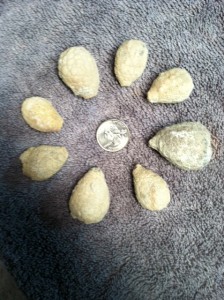
Holocystites found during most recent trip to Massie Shale.
Also exposed were specimens of two less common cystoids: three Caryocrinites and one Paulicystis. Finding 3 Caryocrinites in a single day is most unusual — even finding one can be a challenge. Paulicystis is also not a common find. This genus is a favorite because I found (~1980) the first specimen ever reported — it has since been described in a publication by Harrell Strimple (University of Iowa). This genus is notable for several features:
* squat mushroom-like theca
* wide base (which attached to a short circular holdfast on hard ground)
* the rectangular oral area with four ambulacral feeding grooves radiating outward [and therefore it had only 4 brachioles (arms) instead of the five and the pentagonal oral area found on most genera].
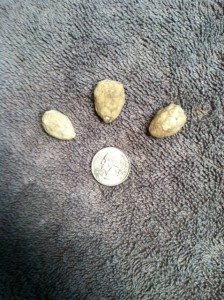
Caryocrinites found on most recent trip to the Massie Shale.

Top view of Paulicystis showing the rectangular oral area.

Side view of Paulicystis showing the squat mushroom-like shaped theca.
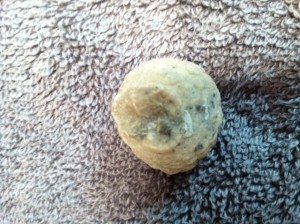
Bottom view of Paulicystis showing the large circular attachment base.
A fragment of a cylindrical Holocystites with many parasitic borings was found. This specimen will be of interest to Dr. Carl Brett (UC) for his studies on borings. And, as in several recent trips, I filled a bag with echinoderm stem sections for Dr. Brett’s studies. In a quick inspection of the collected material, I noted a few with parasitic borings (see picture below). I’m sure that he’ll find more as he sorts the stems by species and examines them more closely.

Fragment of cylindrical Holocystites species with many parasitic borings.
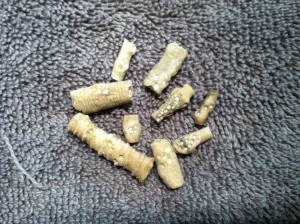
Echinoderm stems with parasitic borings.
From the perspective of a fossil collector, the quarry continues to mine in the wrong direction. Based on our collecting success in the past, they should be mining toward the north and west — that’s where the “hot zone” was. But, alas, they are going east, into an area where even finding a brachiopod can be a challenge. I’ll continue to monitor the quarry for any new shale exposures — because they just might uncover another section with a high concentration of Silurian macro-fossils.
Don Bissett

A long-time member of the Dry Dredgers, I’ve been collecting fossils ever since moving to Cincinnati in 1975 to work at P&G. I was introduced to fossil collecting by Bruce Gibson, another Dry Dredger and co-worker at P&G. Shortly after that, I met Dredger Dan Cooper. Both of them taught me a lot about the hobby. Ever since, I’ve been hooked on fossils.
My primary focus is collecting trilobites and echinoderms, though I often find myself accumulating a much wider assortment of fossils. Beyond the collecting hobby, I’ve also had the opportunity to work with professional paleontologists – extremely rewarding experiences. Some of those have been described in Dry Dredger Bulletin articles, MAPS (Mid-American Paleontology Society) articles, and technical publications. I plan to share more about collecting and professional interactions in my blog posts.Latest posts by Don Bissett (see all)
- Massie Shale Calymene - January 4, 2021
- Mississippian starfish - November 13, 2020
- Walcott-Rust Starfish - October 25, 2020
- Spathacalymene - September 20, 2020
- Penn Dixie Dig with the Experts 2018 - May 27, 2018

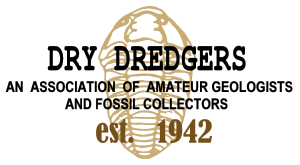



Hi Don,
Loved your specimens from the Massie shale. I am originally from Ohio but live in Minnesota. I visit my sister in Cincinnati a few times a year. When there, I do scrounge around for a few local fossils. Echinoderms are my favorite, hence the enjoyment received from your blog. My question is : does the quarry allow access with permission or is it through the Dry Dredger field trips that you gain access? I would love to find a few samples of what this quarry offers!!!
Mike:
Thanks for your interest in the blog.
Regarding your question, the Massie Shale site is a commercial crushed stone quarry. Permission to collect is possible (though not guaranteed). Required equipment: steel-toed boots, long pants, hard hat. If you want to collect during one of your future trips to Cincinnati, please contact me in advance so I can connect with the quarry in advance.
Be advised, as stated in the blog, echinoderm productivity has dropped off dramatically in the past couple of years. My most recent trip there was unusually productive, considering it’s the same old shale piles that have been collected dozens of times. But since my focus has shifted to include collecting material for the study of parasitic borings, there is plenty of relevant material (echinoderm stems) to pick up.
Don